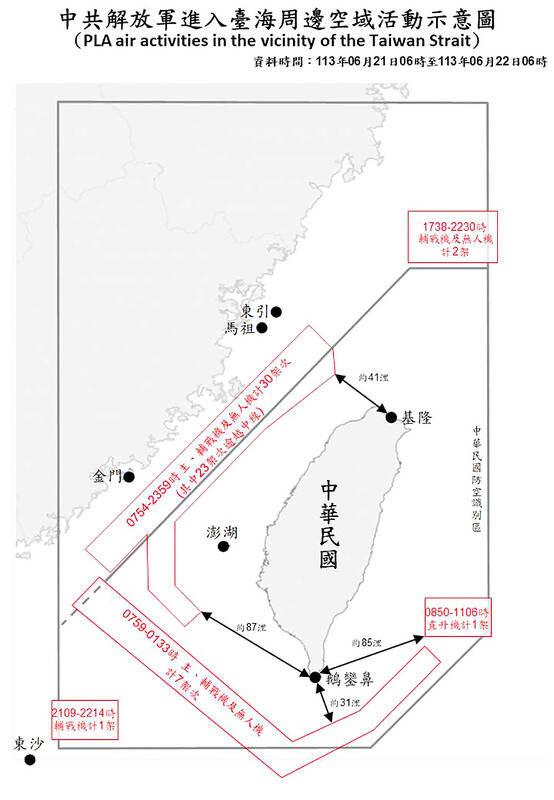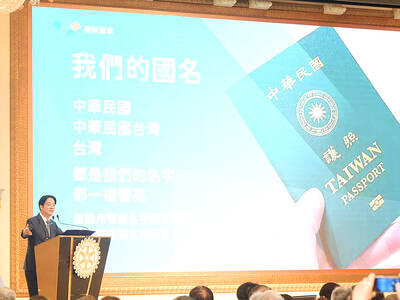China sent 77 military aircraft around Taiwan over a two-day period ending yesterday morning, an uptick in its activity over the past few weeks.
Forty-one Chinese military aircraft were detected in the vicinity of Taiwan in the 24-hour period that ended at 6am yesterday, with 23 crossing the median line of the Taiwan Strait and nine crossing its extension, entering the country’s northern, southwestern and eastern air defense identification zones (ADIZs), flight routes released yesterday by the Ministry of National Defense showed.
Of the nine aircraft that crossed the median line’s extension, were seven fighter jets and two drones that flew around the southwestern ADIZ and entered airspace off the country’s east coast, some flying as close as 31 nautical miles (57.4km) from Oluanpi (鵝鑾鼻), Taiwan’s southernmost tip, ministry data showed.

Photo courtesy of the Ministry of National Defense
An ADIZ is a self-declared area in which a country claims the right to identify, locate and control approaching foreign aircraft, but it is not part of its territorial airspace, as defined by international law.
Seven Chinese People’s Liberation Army (PLA) vessels were detected in waters off Taiwan over the same period, the ministry said, adding that it was closely monitoring the situation and had deployed combat air patrol aircraft, coastal missile systems and navy vessels in response.
In the 24-hour period that ended at 6am on Friday, 36 Chinese military aircraft and seven vessels were detected around Taiwan, ministry data showed.
The latest sorties came as China on Friday fleshed out laws aimed at punishing supporters of Taiwanese independence, a move seen as raising pressure on President William Lai (賴清德) who was inaugurated on May 20.
Separately, fishers from Penghu County on Thursday spotted a PLA Navy guided-missile destroyer near the median line of the Taiwan Strait, two days after a nuclear submarine was seen in the waters around Kinmen County.
A photograph provided by a fisher showed a warship matching the description and pennant number of the Chinese Type 052C destroyer Xi’an.
The destroyer was seen at 6:35am that day, at 23° 16 minutes north, 118° 28 minutes east, or 63.5 nautical miles from Cimei Lighthouse in Penghu, the fisher told Chinese-language media.
The Xi’an was also sighted on March 8 last year, about 40 nautical miles off Pingtung. It is has an active electronically scanned array radar and a vertical launching system capable of attacking surface combatants and submarines.
Type 052C destroyers are noted for their superior long-range detection and air defense capabilities compared with to previous Chinese designs. The Xi’an is the sixth ship of its class in China’s navy.
Additional reporting by Liu Yu-ching

LONG FLIGHT: The jets would be flown by US pilots, with Taiwanese copilots in the two-seat F-16D variant to help familiarize them with the aircraft, the source said The US is expected to fly 10 Lockheed Martin F-16C/D Block 70/72 jets to Taiwan over the coming months to fulfill a long-awaited order of 66 aircraft, a defense official said yesterday. Word that the first batch of the jets would be delivered soon was welcome news to Taiwan, which has become concerned about delays in the delivery of US arms amid rising military tensions with China. Speaking on condition of anonymity, the official said the initial tranche of the nation’s F-16s are rolling off assembly lines in the US and would be flown under their own power to Taiwan by way

OBJECTS AT SEA: Satellites with synthetic-aperture radar could aid in the detection of small Chinese boats attempting to illegally enter Taiwan, the space agency head said Taiwan aims to send the nation’s first low Earth orbit (LEO) satellite into space in 2027, while the first Formosat-8 and Formosat-9 spacecraft are to be launched in October and 2028 respectively, the National Science and Technology Council said yesterday. The council laid out its space development plan in a report reviewed by members of the legislature’s Education and Culture Committee. Six LEO satellites would be produced in the initial phase, with the first one, the B5G-1A, scheduled to be launched in 2027, the council said in the report. Regarding the second satellite, the B5G-1B, the government plans to work with private contractors

‘OF COURSE A COUNTRY’: The president outlined that Taiwan has all the necessary features of a nation, including citizens, land, government and sovereignty President William Lai (賴清德) discussed the meaning of “nation” during a speech in New Taipei City last night, emphasizing that Taiwan is a country as he condemned China’s misinterpretation of UN Resolution 2758. The speech was the first in a series of 10 that Lai is scheduled to give across Taiwan. It is the responsibility of Taiwanese citizens to stand united to defend their national sovereignty, democracy, liberty, way of life and the future of the next generation, Lai said. This is the most important legacy the people of this era could pass on to future generations, he said. Lai went on to discuss

MISSION: The Indo-Pacific region is ‘the priority theater,’ where the task of deterrence extends across the entire region, including Taiwan, the US Pacific Fleet commander said The US Navy’s “mission of deterrence” in the Indo-Pacific theater applies to Taiwan, Pacific Fleet Commander Admiral Stephen Koehler told the South China Sea Conference on Tuesday. The conference, organized by the Center for Strategic and International Studies (CSIS), is an international platform for senior officials and experts from countries with security interests in the region. “The Pacific Fleet’s mission is to deter aggression across the Western Pacific, together with our allies and partners, and to prevail in combat if necessary, Koehler said in the event’s keynote speech. “That mission of deterrence applies regionwide — including the South China Sea and Taiwan,” he